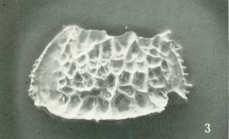
| Intro | | Search taxa | | Bibliography | | Distributions | | Photogallery | | Statistics | | Taxon tree | | Log in |
Ostracoda taxon detailsBradleya japonica Benson, 1972
461419 (urn:lsid:marinespecies.org:taxname:461419)
accepted
Species
marine,
Benson, R.H. (1972). The <i>Bradleya</i> Problem, with descriptions of two new psychrospheric ostracode genera, <i>Agrenocythere</i> and <i>Poseidonamicus</i> (Ostracoda: Crustacea). <em>Smithsonian Contributions to Paleobiology.</em> (12), 1-138., available online at http://si-pddr.si.edu/jspui/handle/10088/1879 [details] Available for editors
Description "This species is the only one known which is nude or smooth in the terminal regions on the carapace, and in the same adult...
Description "This species is the only one known which is nude or smooth in the terminal regions on the carapace, and in the same adult stage has coarse reticular elements over the rest of the carapace. This difference in development in the reticulum is known in early instars of Poseidonamicus, new genus (whose fossae are filled in), but not observed to such an extreme degree before in Bradleya. The earlier ins tars of Bradleya dictyon (Figure 15) have the reticulum somewhat incompletely developed near the anterior margin, suggesting that B. japonica, new species, may be neotonous. The pattern of the reticulum is irregular, especially anterior to the muscle-scar region. The species appears to be transitional in form between the boldly reticular species Bradleya albatrossia, new species, and the smooth B. nuda, new species. All three of these species are common to the western Pacific. Attention is called to a murus that extends downward and slightly toward the anterior from the high peak of the dorsal carina. This same murus, one of the more prominent on the central carapace of B. japonica is clearly identifiable on B. nuda. Both species also have a posteriorly directed process on the posterior cardinal angle, as also does B. paranuda, new species." (Benson, 1972: 40) [details]
Brandão, S. N.; Antonietto, L. S.; Pereira, J. S.; Pereira, S. G. G.; Sá, H. A. B.; Praxedes, R. A.; Sabater, L. M., Santos, S.G.; Karanovic, I. (2025). World Ostracoda Database. Bradleya japonica Benson, 1972. Accessed at: https://www.marinespecies.org/ostracoda/aphia.php?p=taxdetails&id=461419 on 2025-05-06
Date action by
original description
Benson, R.H. (1972). The <i>Bradleya</i> Problem, with descriptions of two new psychrospheric ostracode genera, <i>Agrenocythere</i> and <i>Poseidonamicus</i> (Ostracoda: Crustacea). <em>Smithsonian Contributions to Paleobiology.</em> (12), 1-138., available online at http://si-pddr.si.edu/jspui/handle/10088/1879 [details] Available for editors
 Present Present  Inaccurate Inaccurate  Introduced: alien Introduced: alien  Containing type locality Containing type locality
From editor or global species database
Description "This species is the only one known which is nude or smooth in the terminal regions on the carapace, and in the same adult stage has coarse reticular elements over the rest of the carapace. This difference in development in the reticulum is known in early instars of Poseidonamicus, new genus (whose fossae are filled in), but not observed to such an extreme degree before in Bradleya. The earlier ins tars of Bradleya dictyon (Figure 15) have the reticulum somewhat incompletely developed near the anterior margin, suggesting that B. japonica, new species, may be neotonous. The pattern of the reticulum is irregular, especially anterior to the muscle-scar region. The species appears to be transitional in form between the boldly reticular species Bradleya albatrossia, new species, and the smooth B. nuda, new species. All three of these species are common to the western Pacific. Attention is called to a murus that extends downward and slightly toward the anterior from the high peak of the dorsal carina. This same murus, one of the more prominent on the central carapace of B. japonica is clearly identifiable on B. nuda. Both species also have a posteriorly directed process on the posterior cardinal angle, as also does B. paranuda, new species." (Benson, 1972: 40) [details]Diagnosis "Distinguished from other species of Bradleya by the incomplete development of the reticulum in the anterior and posterior regions near the margin, the confused pattern of the reticulum in the anterior, its broad ventrolateral carina, and its foreshortened and peaked dorsal carina." (Benson, 1972: 40) [details] |

